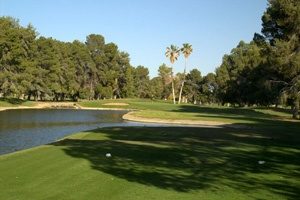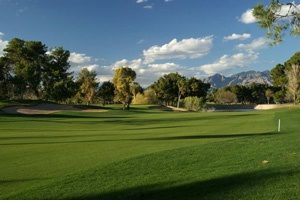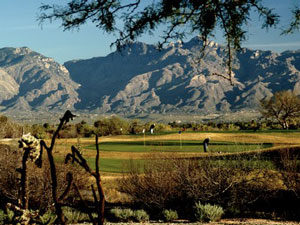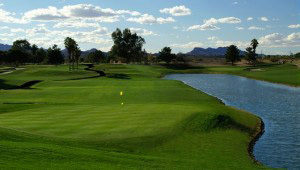Tucson’s history with the game of golf dates back to 1929 when the first of five courses that make up the municipal golf course system opened to the public. Over the past 90+ years, the Old Pueblo’s stable of golf courses have seen many changes. Today, under the management of OB Sports Golf, Tucson’s municipal golf has never provided a more enjoyable experience.
Randolph Park stands as the longest course of the five in the City of Tucson system and, for many public players, the preferred layout. What they don’t see below the surface is a rich history of one of the most popular municipal courses in the United States. The entire Randolph Park complex is an oasis left to the town by railroad tycoon Espes Randolph in the early 1900s. The course was created in 1925, at a time when sand fairways and cottonseed greens were in order, were sprayed with oil to keep them from being swept away by wind and were raked by golfers after they putted out. It was grassed in 1936 under the direction of legendary course designer William F. “Billy” Bell, who slept on the clubhouse floor during the project, which was completed with labor provided by one of President Franklin Roosevelt’s “New Deal” programs. The parkland-style course has been modified over the past 30 years to accommodate tournaments as the host of PGA Tour and LPGA Tour events, adding even more to its history. Annika Sorenstam, who played college golf at the nearby University of Arizona, captured her LPGA Hall of Fame victory here and won the event twice. Randolph Park is a straightforward layout with good bunkering, tree-lined fairways which run parallel, and has water in play on five holes.

Dell Urich Golf Course at Randolph Park is considered the “Little Sister,” but for nearly 50 years, it has been like the favorite uncle to public golfers in southern Arizona. Formerly called Randolph South, it was renamed in honor of the first golf pro at the municipal facility. Together they are the second-most played public golf complex in the country, behind only Torrey Pines. The legendary William F. “Billy” Bell designed Dell Urich, which opened in 1961, plays to par 70 at 6,633 yards from the back tees and features some dramatic elevation changes and two large lakes that come into play on four holes. The course underwent extensive renovation and got its new name in 1996, along with a new clubhouse. It has a traditional, player-friendly design, devoid of the desert hazards that gobble up errant shots, which has particular appeal to many public golfers.

El Rio Golf Course – At first glance, or even second, you probably wouldn’t guess that this is where some of the greatest golfers in the history of the game and many famous celebrities have teed it up, but the Trini Alvarez-El Rio Golf Course is rich with history. The course dates to the early 1930s and was the original site of the Tucson Open, hosting that PGA Tour event 17 times over 18 years. The course was operated as the private El Rio Country Club until 1968 when it was acquired by the City of Tucson for public use. The course, designed by William P. Bell was Tucson’s first grassed course. It features tight fairways, small greens, relatively-flat terrain, two lakes that bring water into play on three holes and is lined with mature trees. The course underwent a major restoration project in 2004 that included a new irrigation system and cart paths and restored bunkers, under the direction of renowned designer Ken Kavanaugh. “We wanted to de-modernize El Rio,” Kavanaugh said when the project was completed. “There are few opportunities to play an old-style golf course like this.”

Fred Enke is a departure from the other four courses owned by the City of Tucson, as it’s the only desert-target layout in the stable. Designed by Dick Phelps and Brad Benz, it opened in 1983 and later underwent a renovation under the direction of Ken Kavanaugh. Visually, this is a semi-arid course with limited turf, but the large greens and ample landing areas offer birdie opportunities for those who keep their ball in play. The tee-boxes, landing areas and greens are grassed and the rest of the course is native desert vegetation, with rugged transition areas that can take a toll on golfers who are hitting it sideways.

Silverbell, built along the west bank of the Santa Cruz River in the northwest corner of Tucson, opened in 1979 and underwent a major renovation in 2004. Originally built on an uncapped landfill, the land began to sink prompting a total makeover directed by hometown course architect Ken Kavanagh. Holes 7-10 are the only ones that remain from the original design by Arthur “Jack” Snyder and three of those were lengthened by adding extra tees. Along with the new holes, many of Silverbell’s two lakes were enlarged, bringing water into play on 5 holes. Adding to the challenge are 40 bunkers strategically placed around the greens. The course is a traditional design, defined by open fairways, large greens and relatively flat terrain. At nearly 7,000 yards, it is now the longest of Tucson’s five “munies” and a favorite of Tucson residents.

If you haven’t played these a round or two at the City of Tucson golf courses, it’s time experience a place that values the history and tradition of the game in a whole new light.







































